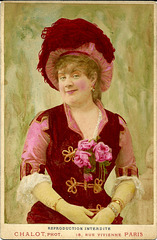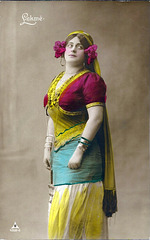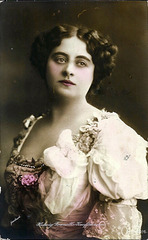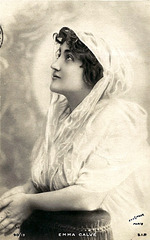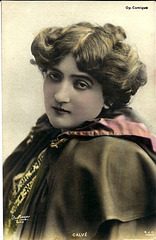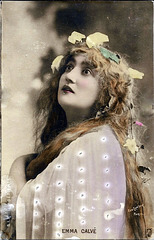OperaMania's photos
Margaret Matzenauer
| |
|
as Waltraute in " Götterdämmerung" by Wagner
Margaret Matzenauer
1 June 1881 – 19 May 1963
Austrian mezzo-soprano
Studied in Graz and Berlin, making her operatic debut in 1901 as Puck in Weber's Oberon. She began singing major roles such as Azucena in Il trovatore, Carmen, Mignon, Waltraute and Erda in the Ring operas and Ortrud in Lohengrin. She first achieved fame in Europe as a contralto and mezzo-soprano, and she was engaged to appear at the 1911 Bayreuth Festival.
Made her debut (as a mezzo) at the New York Metropolitan Opera in Aida on 13 November 1911, singing Amneris. A few days later she displayed her versatility by appearing in Wagner's Tristan und Isolde.Kundry in the opera Parsifal, Matzenauer remained at the Met for a total of 19 seasons, delivering a wide variety of roles including Eboli in the first Met production of Don Carlos (1920), Santuzza, Marina in Boris Godunov, Leonore in Fidelio and Brünnhilde in Die Walküre. She gave her farewell Met performance on 17 February 1930 as Amneris, but she continued singing opera elsewhere and giving concerts.In 1936, she played the part of Madame Pomponi in the Columbia Pictures production of Mr. Deeds Goes to Town.Matzenauer also took up teaching; two of her pupils were mezzo-sopranos Blanche Thebom and Nell Tangeman. Her last stage appearance was in a Broadway comedy, Vicki, in 1942. She died in 1963 at Van Nuys, California
Margaret Matzenauer Autographed
| |
|
Margaret Matzenauer
1 June 1881 – 19 May 1963
Austrian mezzo-soprano
Studied in Graz and Berlin, making her operatic debut in 1901 as Puck in Weber's Oberon. She began singing major roles such as Azucena in Il trovatore, Carmen, Mignon, Waltraute and Erda in the Ring operas and Ortrud in Lohengrin. She first achieved fame in Europe as a contralto and mezzo-soprano, and she was engaged to appear at the 1911 Bayreuth Festival.
Made her debut (as a mezzo) at the New York Metropolitan Opera in Aida on 13 November 1911, singing Amneris. A few days later she displayed her versatility by appearing in Wagner's Tristan und Isolde.Kundry in the opera Parsifal, Matzenauer remained at the Met for a total of 19 seasons, delivering a wide variety of roles including Eboli in the first Met production of Don Carlos (1920), Santuzza, Marina in Boris Godunov, Leonore in Fidelio and Brünnhilde in Die Walküre. She gave her farewell Met performance on 17 February 1930 as Amneris, but she continued singing opera elsewhere and giving concerts.In 1936, she played the part of Madame Pomponi in the Columbia Pictures production of Mr. Deeds Goes to Town.Matzenauer also took up teaching; two of her pupils were mezzo-sopranos Blanche Thebom and Nell Tangeman. Her last stage appearance was in a Broadway comedy, Vicki, in 1942. She died in 1963 at Van Nuys, California
Margaret Matzenauer
| |
|
Margaret Matzenauer
1 June 1881 – 19 May 1963
Austrian mezzo-soprano
Studied in Graz and Berlin, making her operatic debut in 1901 as Puck in Weber's Oberon. She began singing major roles such as Azucena in Il trovatore, Carmen, Mignon, Waltraute and Erda in the Ring operas and Ortrud in Lohengrin. She first achieved fame in Europe as a contralto and mezzo-soprano, and she was engaged to appear at the 1911 Bayreuth Festival.
Made her debut (as a mezzo) at the New York Metropolitan Opera in Aida on 13 November 1911, singing Amneris. A few days later she displayed her versatility by appearing in Wagner's Tristan und Isolde.Kundry in the opera Parsifal, Matzenauer remained at the Met for a total of 19 seasons, delivering a wide variety of roles including Eboli in the first Met production of Don Carlos (1920), Santuzza, Marina in Boris Godunov, Leonore in Fidelio and Brünnhilde in Die Walküre. She gave her farewell Met performance on 17 February 1930 as Amneris, but she continued singing opera elsewhere and giving concerts.In 1936, she played the part of Madame Pomponi in the Columbia Pictures production of Mr. Deeds Goes to Town.Matzenauer also took up teaching; two of her pupils were mezzo-sopranos Blanche Thebom and Nell Tangeman. Her last stage appearance was in a Broadway comedy, Vicki, in 1942. She died in 1963 at Van Nuys, California
She was married to tenor Edoardo Ferrari-Fontana (1878-1936). from 1911-1917
Zdenka Fassbender & Paul Bender
| |
|
as Elektra & Orest in "Elektra" by Strauss
Paul Bender
28 July 1875-25 November 1947
German Bass
Studied in Berlin with Luise Ress and Baptist Hoffmann. Stage debut in 1900 at the Opera House of Breslau (as a hermit in 'Der Freischütz' by Weber), where he remained until 1903; In 1903 at Munich court opera, and remained for 30 years. On 11.27.1903 he was in the premiere of 'Le donne curiose' and on 19.3.1906 in the of 'I quattro rusteghi' by Ermanno Wolf-Ferrari with. On 06.12.1917 he sang at the Prinzregententheater in the premiere of Pfitzner’s 'Palestrina' he created the role of Pope Pius V. In Munich in the premiere of Massenet's “ Don Quichotte 'the title role. . In 1930 he worked in Munich in the premiere of Julius Weismann's 'The Ghost Sonata', 1931 Hans Pfitzner's 'The Heart', on 02.05.1939 it in the world premiere of 'The Moon' by C.Orff as Peter with, 1938 and 1939 sang in the Ring performances at La Scala the Fafner. He has performed at all major German theaters, in At the Bayreuth Festival he joined in 1902 as Fasolt in 'Rheingold' on. Guest performances around the world Monnaie Brussels ,Théâtre des Champs-Elyses Paris , Covent Garden Opera London. Guest performances around the world. Vienna , Zurich.,New York Metropolitan Opera; . In 1926 he sang at the Festival of Salzburg Osmin in the 'Abduction from the Seraglio'. , 1938 and 1939 sang in the Ring performances at La Scala the He, in Amsterdam and Geneva (1931), Stockholm (1935 in concerts), in Budapest (1929 as a concert soloist and 1931) and in Spain. On stage he mastered a repertoire of more than one hundred major roles.He was a much-admired concert and Lieder singer. In 1931 he became a professor at the Munich Academy of Music.
Zdenka Fassbender
12. December 1879 -14. March 1954
Czech soprano
Studied with Sophie Loewe Destinn in Prague. In 1899 she debuted at the Court Theatre of Karlsruhe as Rachel in 'La Juive' by Halévy . In 1903 she was in the premiere of the opera 'Ilsebill' of Fr. Klose in the title role . Munich Court 1905-1924, the most prominent members of the Munich Court Opera (known since 1918 as Bayerische Staatsoper). Performed roles such as Venus in 'Tannhäuser', Ortrud in "Lohengrin", Isolde in "Tristan und Isolde"', Brünnhilde in "the Ring Cycle", Kundry in "Parsifal', Santuzza in 'Cavalleria Rusticana' Iphigenie in Gluck's 'Iphigénie en Tauride', Alceste by Gluck, Valentine in the 'Huguenots' by Meyerbeer, Dido in 'Les Troyens' by Berlioz, Katharina in 'The Taming of the Shrew' by.Goetz, Minneleide in the "Rose vom Liebesgarten" by Hans Pfitzner, the Gundula in ''Der Bergsee' by Bittner , Leonore in Beethoven's 'Fidelio'. She appeared in the Munich premieres of operas 'Tiefland' by d'Albert (1908 as Martha), 'Elektra' by R. Strauss (1908 title role), 'Tosca' (1909 title role), 'Der Rosenkavalier' (1911 Marschallin) , 'Der arme Heinrich' by H.Pfitzner (1913 Hilde), 'Parsifal' (1914 as Kundry) and 'Mona Lisa' by von Schillings (1917 title role) Guest performances she sang in 1910 and 1913 in London, Elektra and Isolde conducted by Sir Thomas Beecham, 1912-14 in the performances of the Ring Cycle at the Théâtre de la Monnaie in Brussels. In 1904 she made guest appearances at the Vienna Court Opera, 1909 at the Berlin Court Opera, also in other major opera houses in Germany, Stuttgart, at the court theaters of Wiesbaden and Mannheim and at the Opera House of Cologne. In 1928 she appeared again at the Munich Staatsoper as Elektra.
Zdenka Fassbender & Maude Fay
| |
|
as Elektra & Chrysothemis in "Elektra" by Strauss
Maude Maude
18 April 1878 – 7 October 1964
American Soprano
Studied with Aglaja von Orgeni in Dresden. Debut in 1906 at the Court Opera in Munich as Marguerite in 'Faust' by Gounod. She stayed until 1914 active in Munich and was primarily known as a Wagner soprano. She sang in 1908 the title role in the Munich premiere of the opera "Donna Diana" by Reznicek, Chrysothemis in" Elektra "(1908) and the title character in' Ariadne auf Naxos' (1913) in the premieres of Richard Strauss operas at the Court Opera in Munich. She had great success there as the Countess in 'The Marriage of Figaro' and as Donna Anna in Don Giovanni; their other roles in Munich were the Elsa in 'Lohengrin', the title role in 'Jessonda' of L.Spohr that Ada in 'The Fairies' by R. Wagner, the Norma and Irene 'Rienzi' by R. Wagner. She also appeared at the City Theatre of Zurich (1909), and Berlin Court Opera (1909), at Frankfurt (1910) and Leipzig (1911). At Covent Garden London, she sang in 1914 as Sieglinde in 'Valkyrie', as Gutrune in 'Götterdämmerung' and as Elsa in 'Lohengrin' Further guest performances at the Court Opera of St. Petersburg, in Brussels and 1912-13 in Amsterdam, where she was Elisabeth in Tannhäuser and Sieglinde in 'Valkyrie' 1915-17 .Metropolitan Opera New York. There she sang in 1916 the role of Sieglinde, and Elsa . In the 1916-17 season she was engaged at the Opera of Chicago. 1920-21 she was again heard at the San Carlo Opera Company in the United States. After she married the American naval officer Powers, she made rare guest performances and concerts.
Zdenka Fassbender
12. December 1879 -14. March 1954
Czech soprano
Studied with Sophie Loewe Destinn in Prague. In 1899 she debuted at the Court Theatre of Karlsruhe as Rachel in 'La Juive' by Halévy . In 1903 she was in the premiere of the opera 'Ilsebill' of Fr. Klose in the title role . Munich Court 1905-1924, the most prominent members of the Munich Court Opera (known since 1918 as Bayerische Staatsoper). Performed roles such as Venus in 'Tannhäuser', Ortrud in "Lohengrin", Isolde in "Tristan und Isolde"', Brünnhilde in "the Ring Cycle", Kundry in "Parsifal', Santuzza in 'Cavalleria Rusticana' Iphigenie in Gluck's 'Iphigénie en Tauride', Alceste by Gluck, Valentine in the 'Huguenots' by Meyerbeer, Dido in 'Les Troyens' by Berlioz, Katharina in 'The Taming of the Shrew' by.Goetz, Minneleide in the "Rose vom Liebesgarten" by Hans Pfitzner, the Gundula in ''Der Bergsee' by Bittner , Leonore in Beethoven's 'Fidelio'. She appeared in the Munich premieres of operas 'Tiefland' by d'Albert (1908 as Martha), 'Elektra' by R. Strauss (1908 title role), 'Tosca' (1909 title role), 'Der Rosenkavalier' (1911 Marschallin) , 'Der arme Heinrich' by H.Pfitzner (1913 Hilde), 'Parsifal' (1914 as Kundry) and 'Mona Lisa' by von Schillings (1917 title role) Guest performances she sang in 1910 and 1913 in London, Elektra and Isolde conducted by Sir Thomas Beecham, 1912-14 in the performances of the Ring Cycle at the Théâtre de la Monnaie in Brussels. In 1904 she made guest appearances at the Vienna Court Opera, 1909 at the Berlin Court Opera, also in other major opera houses in Germany, Stuttgart, at the court theaters of Wiesbaden and Mannheim and at the Opera House of Cologne. In 1928 she appeared again at the Munich Staatsoper as Elektra.
Zdenka Fassbender
| |
|
Zdenka Fassbender
12. December 1879 -14. March 1954
Czech soprano
Studied with Sophie Loewe Destinn in Prague. In 1899 she debuted at the Court Theatre of Karlsruhe as Rachel in 'La Juive' by Halévy . In 1903 she was in the premiere of the opera 'Ilsebill' of Fr. Klose in the title role . Munich Court 1905-1924, the most prominent members of the Munich Court Opera (known since 1918 as Bayerische Staatsoper). Performed roles such as Venus in 'Tannhäuser', Ortrud in "Lohengrin", Isolde in "Tristan und Isolde"', Brünnhilde in "the Ring Cycle", Kundry in "Parsifal', Santuzza in 'Cavalleria Rusticana' Iphigenie in Gluck's 'Iphigénie en Tauride', Alceste by Gluck, Valentine in the 'Huguenots' by Meyerbeer, Dido in 'Les Troyens' by Berlioz, Katharina in 'The Taming of the Shrew' by.Goetz, Minneleide in the "Rose vom Liebesgarten" by Hans Pfitzner, the Gundula in ''Der Bergsee' by Bittner , Leonore in Beethoven's 'Fidelio'. She appeared in the Munich premieres of operas 'Tiefland' by d'Albert (1908 as Martha), 'Elektra' by R. Strauss (1908 title role), 'Tosca' (1909 title role), 'Der Rosenkavalier' (1911 Marschallin) , 'Der arme Heinrich' by H.Pfitzner (1913 Hilde), 'Parsifal' (1914 as Kundry) and 'Mona Lisa' by von Schillings (1917 title role) Guest performances she sang in 1910 and 1913 in London, Elektra and Isolde conducted by Sir Thomas Beecham, 1912-14 in the performances of the Ring Cycle at the Théâtre de la Monnaie in Brussels. In 1904 she made guest appearances at the Vienna Court Opera, 1909 at the Berlin Court Opera, also in other major opera houses in Germany, Stuttgart, at the court theaters of Wiesbaden and Mannheim and at the Opera House of Cologne. In 1928 she appeared again at the Munich Staatsoper as Elektra.
Marie Desclauzas by Chalot
| |
|
MARIE DESCLAUZAS
(Malvina-Ernestine Armand )
1840-1912
French Soprano
She created the rôle of Mademoiselle Lange in Charles Lecocq’s “La fille de Madame Angot” (1872); the rôle of La belle cousine in Hervé’s “Alice de Nevers” (1875) and the rôle of Diane de Chateau-Lansac in Lecocq’s “Le petit Duc” (1878).
Hedwig Francillo-Kauffmann
| |
|
as Lakme "Lakme" by Delibes
HEDWIG FRANCILLO-KAUFFMANN
1878-1948
Austrian Soprano
Studied with Franzi Müller and Emilie Dorr in Vienna, then by Aglaia of Orgeni in Dresden and Maestro Rosario in Milan. Debut in 1898 at the Municipal Theatre of Szczecin.She sang 1899-1902 at the Court Theatre of Wiesbaden, 1902-03 at the Court Opera in Munich, 1903-05 at the Berlin Court Opera. 1905-07 great success at the Komische Oper Berlin. 1907-08 she sang again at the Court Opera Berlin;In 1908 at the Vienna Court Opera, where she worked with brilliant successes until 1912. 1912-1917 she sang at the Opera House of Hamburg. After 1917, she made guest performances and concerts which took her to Vienna, Berlin, Brussels, Paris, London and Munich, but also to South America. In 1927 she gave up her career as a teacher and lived in Berlin and then Vienna
Hedwig Francillo-Kauffmann
| |
|
as Lakme "Lakme" by Delibes
HEDWIG FRANCILLO-KAUFFMANN
1878-1948
Austrian Soprano
Studied with Franzi Müller and Emilie Dorr in Vienna, then by Aglaia of Orgeni in Dresden and Maestro Rosario in Milan. Debut in 1898 at the Municipal Theatre of Szczecin.She sang 1899-1902 at the Court Theatre of Wiesbaden, 1902-03 at the Court Opera in Munich, 1903-05 at the Berlin Court Opera. 1905-07 great success at the Komische Oper Berlin. 1907-08 she sang again at the Court Opera Berlin;In 1908 at the Vienna Court Opera, where she worked with brilliant successes until 1912. 1912-1917 she sang at the Opera House of Hamburg. After 1917, she made guest performances and concerts which took her to Vienna, Berlin, Brussels, Paris, London and Munich, but also to South America. In 1927 she gave up her career as a teacher and lived in Berlin and then Vienna
Hedwig Francillo-Kauffmann
| |
|
as Lakme "Lakme" by Delibes
HEDWIG FRANCILLO-KAUFFMANN
1878-1948
Austrian Soprano
Studied with Franzi Müller and Emilie Dorr in Vienna, then by Aglaia of Orgeni in Dresden and Maestro Rosario in Milan. Debut in 1898 at the Municipal Theatre of Szczecin.She sang 1899-1902 at the Court Theatre of Wiesbaden, 1902-03 at the Court Opera in Munich, 1903-05 at the Berlin Court Opera. 1905-07 great success at the Komische Oper Berlin. 1907-08 she sang again at the Court Opera Berlin;In 1908 at the Vienna Court Opera, where she worked with brilliant successes until 1912. 1912-1917 she sang at the Opera House of Hamburg. After 1917, she made guest performances and concerts which took her to Vienna, Berlin, Brussels, Paris, London and Munich, but also to South America. In 1927 she gave up her career as a teacher and lived in Berlin and then Vienna
Hedwig Francillo-Kauffmann
| |
|
HEDWIG FRANCILLO-KAUFFMANN
1878-1948
Austrian Soprano
Studied with Franzi Müller and Emilie Dorr in Vienna, then by Aglaia of Orgeni in Dresden and Maestro Rosario in Milan. Debut in 1898 at the Municipal Theatre of Szczecin.She sang 1899-1902 at the Court Theatre of Wiesbaden, 1902-03 at the Court Opera in Munich, 1903-05 at the Berlin Court Opera. 1905-07 great success at the Komische Oper Berlin. 1907-08 she sang again at the Court Opera Berlin;In 1908 at the Vienna Court Opera, where she worked with brilliant successes until 1912. 1912-1917 she sang at the Opera House of Hamburg. After 1917, she made guest performances and concerts which took her to Vienna, Berlin, Brussels, Paris, London and Munich, but also to South America. In 1927 she gave up her career as a teacher and lived in Berlin and then Vienna
Hedwig Francillo-Kauffmann
| |
|
HEDWIG FRANCILLO-KAUFFMANN
1878-1948
Austrian Soprano
Studied with Franzi Müller and Emilie Dorr in Vienna, then by Aglaia of Orgeni in Dresden and Maestro Rosario in Milan. Debut in 1898 at the Municipal Theatre of Szczecin.She sang 1899-1902 at the Court Theatre of Wiesbaden, 1902-03 at the Court Opera in Munich, 1903-05 at the Berlin Court Opera. 1905-07 great success at the Komische Oper Berlin. 1907-08 she sang again at the Court Opera Berlin;In 1908 at the Vienna Court Opera, where she worked with brilliant successes until 1912. 1912-1917 she sang at the Opera House of Hamburg. After 1917, she made guest performances and concerts which took her to Vienna, Berlin, Brussels, Paris, London and Munich, but also to South America. In 1927 she gave up her career as a teacher and lived in Berlin and then Vienna
Emma Calve
| |
|
EMMA CALVE
(Rosa Emma Calvet de Noëmie Roquer)
(August 15, 1858 – January 6, 1942), French Soprano
Her operatic debut occurred on September 23, 1881, in Gounod's Faust at Brussels' La Monnaie. Later she sang at La Scala in Milan, and also at the principal theatres of Naples, Rome, and Florence.
Returning to Paris in 1891, she created the part of Suzel in L'amico Fritz by Pietro Mascagni, playing and singing the role later at Rome. Because of her great success in it, she was chosen to appear[citation needed] as Santuzza in the French premiere of Cavalleria rusticana, which was viewed as one of her greatest parts. She repeated her success in it in London.
Her next triumph was Bizet's Carmen. Before beginning the study of this part, she went to Spain, learned the Spanish dances, mingled with the people and patterned her characterization after the cigarette girls whom she watched at their work and at play. In 1894, she made her appearance in the role at the Opéra-Comique, Paris. The city's opera-goers immediately hailed her as the greatest Carmen that had ever appeared, a verdict other cities would later echo. She had had many famous predecessors in the role, including Adelina Patti, Minnie Hauk and Célestine Galli-Marié, but critics and musicians agreed that in Calvé they had found their ideal of Bizet's cigarette girl of Seville.
Calvé first appeared in America in the season of 1893–1894 as Mignon. She would make regular visits to the country, both in grand opera and in concert tours. After making her Metropolitan Opera debut as Santuzza, she went on to appear a total of 261 times with the company between 1893 and 1904. She created the part of Anita, which was written for her, in Massenet's La Navarraise in London in 1894 and sang Sapho in an opera written by the same composer.
She sang Ophélie in Ambroise Thomas's Hamlet in Paris in 1899, but the part was not suited to her and she dropped it. She appeared with success in many roles, among them, as the Countess in The Marriage of Figaro, the title role in Félicien David's Lalla-Rookh, as Pamina in The Magic Flute, and as Camille in Hérold's Zampa, but she is best known as Carmen
.
Emma Calve
| |
|
EMMA CALVE
(Rosa Emma Calvet de Noëmie Roquer)
(August 15, 1858 – January 6, 1942), French Soprano
Her operatic debut occurred on September 23, 1881, in Gounod's Faust at Brussels' La Monnaie. Later she sang at La Scala in Milan, and also at the principal theatres of Naples, Rome, and Florence.
Returning to Paris in 1891, she created the part of Suzel in L'amico Fritz by Pietro Mascagni, playing and singing the role later at Rome. Because of her great success in it, she was chosen to appear[citation needed] as Santuzza in the French premiere of Cavalleria rusticana, which was viewed as one of her greatest parts. She repeated her success in it in London.
Her next triumph was Bizet's Carmen. Before beginning the study of this part, she went to Spain, learned the Spanish dances, mingled with the people and patterned her characterization after the cigarette girls whom she watched at their work and at play. In 1894, she made her appearance in the role at the Opéra-Comique, Paris. The city's opera-goers immediately hailed her as the greatest Carmen that had ever appeared, a verdict other cities would later echo. She had had many famous predecessors in the role, including Adelina Patti, Minnie Hauk and Célestine Galli-Marié, but critics and musicians agreed that in Calvé they had found their ideal of Bizet's cigarette girl of Seville.
Calvé first appeared in America in the season of 1893–1894 as Mignon. She would make regular visits to the country, both in grand opera and in concert tours. After making her Metropolitan Opera debut as Santuzza, she went on to appear a total of 261 times with the company between 1893 and 1904. She created the part of Anita, which was written for her, in Massenet's La Navarraise in London in 1894 and sang Sapho in an opera written by the same composer.
She sang Ophélie in Ambroise Thomas's Hamlet in Paris in 1899, but the part was not suited to her and she dropped it. She appeared with success in many roles, among them, as the Countess in The Marriage of Figaro, the title role in Félicien David's Lalla-Rookh, as Pamina in The Magic Flute, and as Camille in Hérold's Zampa, but she is best known as Carmen
.
Emma Calve
| |
|
as Margurite 'Faust" by Gounod
EMMA CALVE
(Rosa Emma Calvet de Noëmie Roquer)
(August 15, 1858 – January 6, 1942), French Soprano
Her operatic debut occurred on September 23, 1881, in Gounod's Faust at Brussels' La Monnaie. Later she sang at La Scala in Milan, and also at the principal theatres of Naples, Rome, and Florence.
Returning to Paris in 1891, she created the part of Suzel in L'amico Fritz by Pietro Mascagni, playing and singing the role later at Rome. Because of her great success in it, she was chosen to appear[citation needed] as Santuzza in the French premiere of Cavalleria rusticana, which was viewed as one of her greatest parts. She repeated her success in it in London.
Her next triumph was Bizet's Carmen. Before beginning the study of this part, she went to Spain, learned the Spanish dances, mingled with the people and patterned her characterization after the cigarette girls whom she watched at their work and at play. In 1894, she made her appearance in the role at the Opéra-Comique, Paris. The city's opera-goers immediately hailed her as the greatest Carmen that had ever appeared, a verdict other cities would later echo. She had had many famous predecessors in the role, including Adelina Patti, Minnie Hauk and Célestine Galli-Marié, but critics and musicians agreed that in Calvé they had found their ideal of Bizet's cigarette girl of Seville.
Calvé first appeared in America in the season of 1893–1894 as Mignon. She would make regular visits to the country, both in grand opera and in concert tours. After making her Metropolitan Opera debut as Santuzza, she went on to appear a total of 261 times with the company between 1893 and 1904. She created the part of Anita, which was written for her, in Massenet's La Navarraise in London in 1894 and sang Sapho in an opera written by the same composer.
She sang Ophélie in Ambroise Thomas's Hamlet in Paris in 1899, but the part was not suited to her and she dropped it. She appeared with success in many roles, among them, as the Countess in The Marriage of Figaro, the title role in Félicien David's Lalla-Rookh, as Pamina in The Magic Flute, and as Camille in Hérold's Zampa, but she is best known as Carmen
Emma Calve
| |
|
As Santuzza "Cavaleria Rusticana" by Mascagni
EMMA CALVE
(Rosa Emma Calvet de Noëmie Roquer)
(August 15, 1858 – January 6, 1942), French Soprano
Her operatic debut occurred on September 23, 1881, in Gounod's Faust at Brussels' La Monnaie. Later she sang at La Scala in Milan, and also at the principal theatres of Naples, Rome, and Florence.
Returning to Paris in 1891, she created the part of Suzel in L'amico Fritz by Pietro Mascagni, playing and singing the role later at Rome. Because of her great success in it, she was chosen to appear[citation needed] as Santuzza in the French premiere of Cavalleria rusticana, which was viewed as one of her greatest parts. She repeated her success in it in London.
Her next triumph was Bizet's Carmen. Before beginning the study of this part, she went to Spain, learned the Spanish dances, mingled with the people and patterned her characterization after the cigarette girls whom she watched at their work and at play. In 1894, she made her appearance in the role at the Opéra-Comique, Paris. The city's opera-goers immediately hailed her as the greatest Carmen that had ever appeared, a verdict other cities would later echo. She had had many famous predecessors in the role, including Adelina Patti, Minnie Hauk and Célestine Galli-Marié, but critics and musicians agreed that in Calvé they had found their ideal of Bizet's cigarette girl of Seville.
Calvé first appeared in America in the season of 1893–1894 as Mignon. She would make regular visits to the country, both in grand opera and in concert tours. After making her Metropolitan Opera debut as Santuzza, she went on to appear a total of 261 times with the company between 1893 and 1904. She created the part of Anita, which was written for her, in Massenet's La Navarraise in London in 1894 and sang Sapho in an opera written by the same composer.
She sang Ophélie in Ambroise Thomas's Hamlet in Paris in 1899, but the part was not suited to her and she dropped it. She appeared with success in many roles, among them, as the Countess in The Marriage of Figaro, the title role in Félicien David's Lalla-Rookh, as Pamina in The Magic Flute, and as Camille in Hérold's Zampa, but she is best known as Carmen
.
Emma Calve
| |
|
As Opelia "Hamlet" by Thomas
EMMA CALVE
(Rosa Emma Calvet de Noëmie Roquer)
(August 15, 1858 – January 6, 1942), French Soprano
Her operatic debut occurred on September 23, 1881, in Gounod's Faust at Brussels' La Monnaie. Later she sang at La Scala in Milan, and also at the principal theatres of Naples, Rome, and Florence.
Returning to Paris in 1891, she created the part of Suzel in L'amico Fritz by Pietro Mascagni, playing and singing the role later at Rome. Because of her great success in it, she was chosen to appear[citation needed] as Santuzza in the French premiere of Cavalleria rusticana, which was viewed as one of her greatest parts. She repeated her success in it in London.
Her next triumph was Bizet's Carmen. Before beginning the study of this part, she went to Spain, learned the Spanish dances, mingled with the people and patterned her characterization after the cigarette girls whom she watched at their work and at play. In 1894, she made her appearance in the role at the Opéra-Comique, Paris. The city's opera-goers immediately hailed her as the greatest Carmen that had ever appeared, a verdict other cities would later echo. She had had many famous predecessors in the role, including Adelina Patti, Minnie Hauk and Célestine Galli-Marié, but critics and musicians agreed that in Calvé they had found their ideal of Bizet's cigarette girl of Seville.
Calvé first appeared in America in the season of 1893–1894 as Mignon. She would make regular visits to the country, both in grand opera and in concert tours. After making her Metropolitan Opera debut as Santuzza, she went on to appear a total of 261 times with the company between 1893 and 1904. She created the part of Anita, which was written for her, in Massenet's La Navarraise in London in 1894 and sang Sapho in an opera written by the same composer.
She sang Ophélie in Ambroise Thomas's Hamlet in Paris in 1899, but the part was not suited to her and she dropped it. She appeared with success in many roles, among them, as the Countess in The Marriage of Figaro, the title role in Félicien David's Lalla-Rookh, as Pamina in The Magic Flute, and as Camille in Hérold's Zampa, but she is best known as Carmen
.
Emma Calve
| |
|
As Carmen " Carmen" by Bizet
EMMA CALVE
(Rosa Emma Calvet de Noëmie Roquer)
(August 15, 1858 – January 6, 1942), French Soprano
Her operatic debut occurred on September 23, 1881, in Gounod's Faust at Brussels' La Monnaie. Later she sang at La Scala in Milan, and also at the principal theatres of Naples, Rome, and Florence.
Returning to Paris in 1891, she created the part of Suzel in L'amico Fritz by Pietro Mascagni, playing and singing the role later at Rome. Because of her great success in it, she was chosen to appear[citation needed] as Santuzza in the French premiere of Cavalleria rusticana, which was viewed as one of her greatest parts. She repeated her success in it in London.
Her next triumph was Bizet's Carmen. Before beginning the study of this part, she went to Spain, learned the Spanish dances, mingled with the people and patterned her characterization after the cigarette girls whom she watched at their work and at play. In 1894, she made her appearance in the role at the Opéra-Comique, Paris. The city's opera-goers immediately hailed her as the greatest Carmen that had ever appeared, a verdict other cities would later echo. She had had many famous predecessors in the role, including Adelina Patti, Minnie Hauk and Célestine Galli-Marié, but critics and musicians agreed that in Calvé they had found their ideal of Bizet's cigarette girl of Seville.
Calvé first appeared in America in the season of 1893–1894 as Mignon. She would make regular visits to the country, both in grand opera and in concert tours. After making her Metropolitan Opera debut as Santuzza, she went on to appear a total of 261 times with the company between 1893 and 1904. She created the part of Anita, which was written for her, in Massenet's La Navarraise in London in 1894 and sang Sapho in an opera written by the same composer.
She sang Ophélie in Ambroise Thomas's Hamlet in Paris in 1899, but the part was not suited to her and she dropped it. She appeared with success in many roles, among them, as the Countess in The Marriage of Figaro, the title role in Félicien David's Lalla-Rookh, as Pamina in The Magic Flute, and as Camille in Hérold's Zampa, but she is best known as Carmen
.







